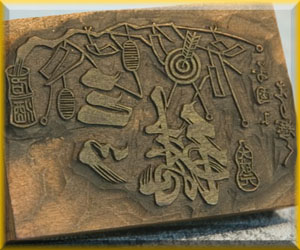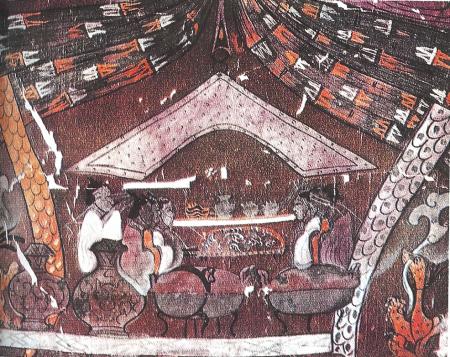Survey 1: ca. 200 BCE
What is relief printing anyways?
Relief printing really refers to woodcut or woodblock printing. The technical term for woodcut is actually xylography but is a term less used in English.
Woodcut is a technique of relief printing used for printing text, images or patterns. It was used widely throughout East Asia and originated in China in antiquity as a method of printing on textiles before paper.
A design is first drawn on the surface of the woodblock while the undrawn parts are cut away along the wood grain with a knife or chisel, leaving the characters or image to show in colour at the surface level. The design is then transferred to the preferred print medium and the print results in a reverse/ mirror-image, proving to be challenging when printing text.
When it comes to printing colour, separate blocks are individually inked and applied, though overprinting two colours may produce different colours on the print.
There are two general methods of transferring prints explained on the right.
Stamping
Much like you would think, it involves pressing the inked woodblock to the desired medium like that of a rubber stamp on paper. Although it was not known to be a method used in woodblock at the time, printing with small stamps used to mark the seal of the emperor or pharaoh on materials that could receive an image, such as wood or clay plates, were used in ancient China as well as in ancient Egypt.
Rubbing
Rubbing is the method of placing the medium on top of the ink-wetted woodblock, then gently rubbing the medium against the ink-wetted surface of the woodblock underneath, often using a weighted rounded tool.

You may know woodblock printing today is used to print many things, from books to fine art, but did you know it has long been an art form that traces back to ancient origins such as China, Egypt, Assyria, and India?

Coloured woodcut Buddha, 10th century, China. 
A part of the Taoist manuscript, ink on silk, 2nd century BCE, Han Dynasty, unearthed from Mawangdui tomb 3rd.
https://en.wikipedia.org/wiki/Woodblock_printing#Origins_in_Asia
Printing on textiles in China
Interestingly the application of block printing began on textiles. Woodblock printing on textiles involved printing patterns on textiles that were usually linen, cotton or silk. Though silk was more a luxury fabric and a symbol of Chinese culture, cotton cloth ultimately became a widespread material and an economic staple.
The earliest example of a Chinese woodblock image on textiles is a fragment of silk cloth with a flower motif in three colours that dates from the Eastern Han Dynasty. Older techniques in China involved using bronze or stone seals to make impressions on malleable materials like clay or silk and taking rubbings from reliefs made of bronze or stone.
Examples Uncovered
Printed silks found at the noble tombs at Mawangdui, Hunan province correspond to a relief stamp found in the tomb of the Second King of Nan Yue (in Guangzhou, datable to before 122 B.C.E.). It was an exciting finding that meant techniques and styles had spread throughout the empire.

<https://fashion-history.lovetoknow.com/fabrics-fibers/chinese-textiles>
Han tombs have yielded a variety of silks, including plain weave, gauze weave, both plain and patterned, and pile-loop brocade similar to velvet. More than twenty dyed colours have been identified. The embellishment of woven fabrics included new techniques of embroidery incorporating gold or feathers, as well as block-printing, stencilling, and painting on silk.
Block printing by hand may be a tedious process but it yields highly satisfying results, which other methods can’t replicate the same way.
Despite the convenience of newer technology, woodblock printing is a timeless art form that remains relevant in fashion and textiles. Whether a designer is using the technique as inspiration for a digital print or carving a stamp, the look is beautifully organic and timeless.
One reply on “Origins of Relief printing on textiles in China.”
Thank you for sharing, what’s next?